Zhengqin Li
DGS-LRM: Real-Time Deformable 3D Gaussian Reconstruction From Monocular Videos
Jun 11, 2025
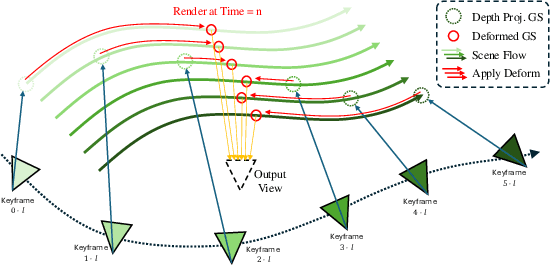
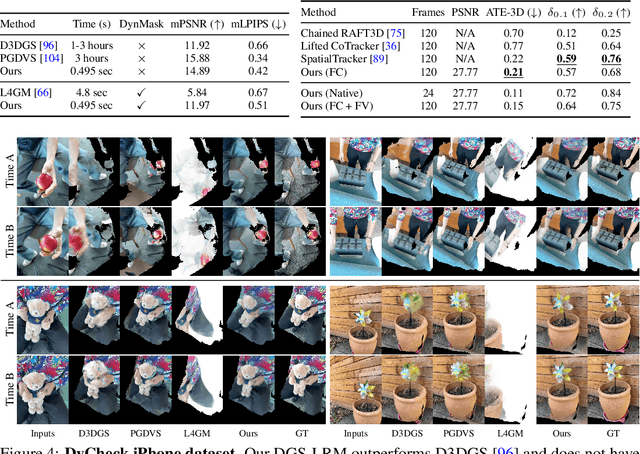
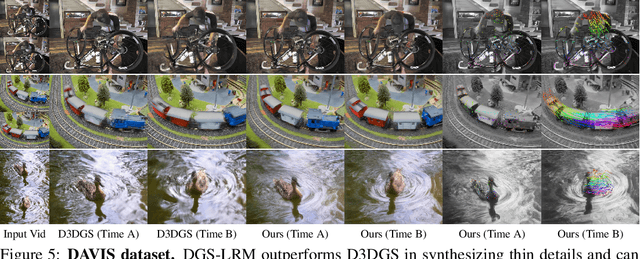
Abstract:We introduce the Deformable Gaussian Splats Large Reconstruction Model (DGS-LRM), the first feed-forward method predicting deformable 3D Gaussian splats from a monocular posed video of any dynamic scene. Feed-forward scene reconstruction has gained significant attention for its ability to rapidly create digital replicas of real-world environments. However, most existing models are limited to static scenes and fail to reconstruct the motion of moving objects. Developing a feed-forward model for dynamic scene reconstruction poses significant challenges, including the scarcity of training data and the need for appropriate 3D representations and training paradigms. To address these challenges, we introduce several key technical contributions: an enhanced large-scale synthetic dataset with ground-truth multi-view videos and dense 3D scene flow supervision; a per-pixel deformable 3D Gaussian representation that is easy to learn, supports high-quality dynamic view synthesis, and enables long-range 3D tracking; and a large transformer network that achieves real-time, generalizable dynamic scene reconstruction. Extensive qualitative and quantitative experiments demonstrate that DGS-LRM achieves dynamic scene reconstruction quality comparable to optimization-based methods, while significantly outperforming the state-of-the-art predictive dynamic reconstruction method on real-world examples. Its predicted physically grounded 3D deformation is accurate and can readily adapt for long-range 3D tracking tasks, achieving performance on par with state-of-the-art monocular video 3D tracking methods.
4DGT: Learning a 4D Gaussian Transformer Using Real-World Monocular Videos
Jun 09, 2025Abstract:We propose 4DGT, a 4D Gaussian-based Transformer model for dynamic scene reconstruction, trained entirely on real-world monocular posed videos. Using 4D Gaussian as an inductive bias, 4DGT unifies static and dynamic components, enabling the modeling of complex, time-varying environments with varying object lifespans. We proposed a novel density control strategy in training, which enables our 4DGT to handle longer space-time input and remain efficient rendering at runtime. Our model processes 64 consecutive posed frames in a rolling-window fashion, predicting consistent 4D Gaussians in the scene. Unlike optimization-based methods, 4DGT performs purely feed-forward inference, reducing reconstruction time from hours to seconds and scaling effectively to long video sequences. Trained only on large-scale monocular posed video datasets, 4DGT can outperform prior Gaussian-based networks significantly in real-world videos and achieve on-par accuracy with optimization-based methods on cross-domain videos. Project page: https://4dgt.github.io
Monocular Online Reconstruction with Enhanced Detail Preservation
May 14, 2025Abstract:We propose an online 3D Gaussian-based dense mapping framework for photorealistic details reconstruction from a monocular image stream. Our approach addresses two key challenges in monocular online reconstruction: distributing Gaussians without relying on depth maps and ensuring both local and global consistency in the reconstructed maps. To achieve this, we introduce two key modules: the Hierarchical Gaussian Management Module for effective Gaussian distribution and the Global Consistency Optimization Module for maintaining alignment and coherence at all scales. In addition, we present the Multi-level Occupancy Hash Voxels (MOHV), a structure that regularizes Gaussians for capturing details across multiple levels of granularity. MOHV ensures accurate reconstruction of both fine and coarse geometries and textures, preserving intricate details while maintaining overall structural integrity. Compared to state-of-the-art RGB-only and even RGB-D methods, our framework achieves superior reconstruction quality with high computational efficiency. Moreover, it integrates seamlessly with various tracking systems, ensuring generality and scalability.
LIRM: Large Inverse Rendering Model for Progressive Reconstruction of Shape, Materials and View-dependent Radiance Fields
Apr 28, 2025Abstract:We present Large Inverse Rendering Model (LIRM), a transformer architecture that jointly reconstructs high-quality shape, materials, and radiance fields with view-dependent effects in less than a second. Our model builds upon the recent Large Reconstruction Models (LRMs) that achieve state-of-the-art sparse-view reconstruction quality. However, existing LRMs struggle to reconstruct unseen parts accurately and cannot recover glossy appearance or generate relightable 3D contents that can be consumed by standard Graphics engines. To address these limitations, we make three key technical contributions to build a more practical multi-view 3D reconstruction framework. First, we introduce an update model that allows us to progressively add more input views to improve our reconstruction. Second, we propose a hexa-plane neural SDF representation to better recover detailed textures, geometry and material parameters. Third, we develop a novel neural directional-embedding mechanism to handle view-dependent effects. Trained on a large-scale shape and material dataset with a tailored coarse-to-fine training scheme, our model achieves compelling results. It compares favorably to optimization-based dense-view inverse rendering methods in terms of geometry and relighting accuracy, while requiring only a fraction of the inference time.
Digital Twin Catalog: A Large-Scale Photorealistic 3D Object Digital Twin Dataset
Apr 11, 2025



Abstract:We introduce Digital Twin Catalog (DTC), a new large-scale photorealistic 3D object digital twin dataset. A digital twin of a 3D object is a highly detailed, virtually indistinguishable representation of a physical object, accurately capturing its shape, appearance, physical properties, and other attributes. Recent advances in neural-based 3D reconstruction and inverse rendering have significantly improved the quality of 3D object reconstruction. Despite these advancements, there remains a lack of a large-scale, digital twin quality real-world dataset and benchmark that can quantitatively assess and compare the performance of different reconstruction methods, as well as improve reconstruction quality through training or fine-tuning. Moreover, to democratize 3D digital twin creation, it is essential to integrate creation techniques with next-generation egocentric computing platforms, such as AR glasses. Currently, there is no dataset available to evaluate 3D object reconstruction using egocentric captured images. To address these gaps, the DTC dataset features 2,000 scanned digital twin-quality 3D objects, along with image sequences captured under different lighting conditions using DSLR cameras and egocentric AR glasses. This dataset establishes the first comprehensive real-world evaluation benchmark for 3D digital twin creation tasks, offering a robust foundation for comparing and improving existing reconstruction methods. The DTC dataset is already released at https://www.projectaria.com/datasets/dtc/ and we will also make the baseline evaluations open-source.
3D Mesh Editing using Masked LRMs
Dec 11, 2024Abstract:We present a novel approach to mesh shape editing, building on recent progress in 3D reconstruction from multi-view images. We formulate shape editing as a conditional reconstruction problem, where the model must reconstruct the input shape with the exception of a specified 3D region, in which the geometry should be generated from the conditional signal. To this end, we train a conditional Large Reconstruction Model (LRM) for masked reconstruction, using multi-view consistent masks rendered from a randomly generated 3D occlusion, and using one clean viewpoint as the conditional signal. During inference, we manually define a 3D region to edit and provide an edited image from a canonical viewpoint to fill in that region. We demonstrate that, in just a single forward pass, our method not only preserves the input geometry in the unmasked region through reconstruction capabilities on par with SoTA, but is also expressive enough to perform a variety of mesh edits from a single image guidance that past works struggle with, while being 10x faster than the top-performing competing prior work.
NeRF Analogies: Example-Based Visual Attribute Transfer for NeRFs
Feb 13, 2024



Abstract:A Neural Radiance Field (NeRF) encodes the specific relation of 3D geometry and appearance of a scene. We here ask the question whether we can transfer the appearance from a source NeRF onto a target 3D geometry in a semantically meaningful way, such that the resulting new NeRF retains the target geometry but has an appearance that is an analogy to the source NeRF. To this end, we generalize classic image analogies from 2D images to NeRFs. We leverage correspondence transfer along semantic affinity that is driven by semantic features from large, pre-trained 2D image models to achieve multi-view consistent appearance transfer. Our method allows exploring the mix-and-match product space of 3D geometry and appearance. We show that our method outperforms traditional stylization-based methods and that a large majority of users prefer our method over several typical baselines.
ReplaceAnything3D:Text-Guided 3D Scene Editing with Compositional Neural Radiance Fields
Jan 31, 2024Abstract:We introduce ReplaceAnything3D model (RAM3D), a novel text-guided 3D scene editing method that enables the replacement of specific objects within a scene. Given multi-view images of a scene, a text prompt describing the object to replace, and a text prompt describing the new object, our Erase-and-Replace approach can effectively swap objects in the scene with newly generated content while maintaining 3D consistency across multiple viewpoints. We demonstrate the versatility of ReplaceAnything3D by applying it to various realistic 3D scenes, showcasing results of modified foreground objects that are well-integrated with the rest of the scene without affecting its overall integrity.
IRIS: Inverse Rendering of Indoor Scenes from Low Dynamic Range Images
Jan 23, 2024Abstract:While numerous 3D reconstruction and novel-view synthesis methods allow for photorealistic rendering of a scene from multi-view images easily captured with consumer cameras, they bake illumination in their representations and fall short of supporting advanced applications like material editing, relighting, and virtual object insertion. The reconstruction of physically based material properties and lighting via inverse rendering promises to enable such applications. However, most inverse rendering techniques require high dynamic range (HDR) images as input, a setting that is inaccessible to most users. We present a method that recovers the physically based material properties and spatially-varying HDR lighting of a scene from multi-view, low-dynamic-range (LDR) images. We model the LDR image formation process in our inverse rendering pipeline and propose a novel optimization strategy for material, lighting, and a camera response model. We evaluate our approach with synthetic and real scenes compared to the state-of-the-art inverse rendering methods that take either LDR or HDR input. Our method outperforms existing methods taking LDR images as input, and allows for highly realistic relighting and object insertion.
TextureDreamer: Image-guided Texture Synthesis through Geometry-aware Diffusion
Jan 17, 2024
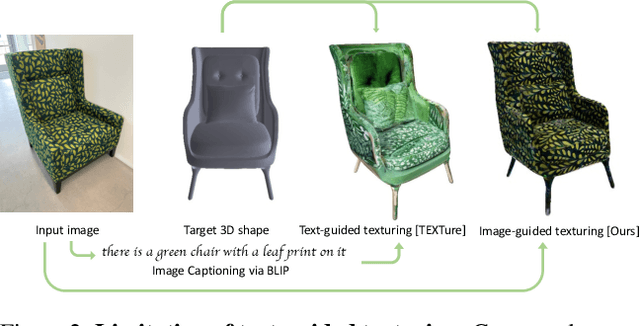

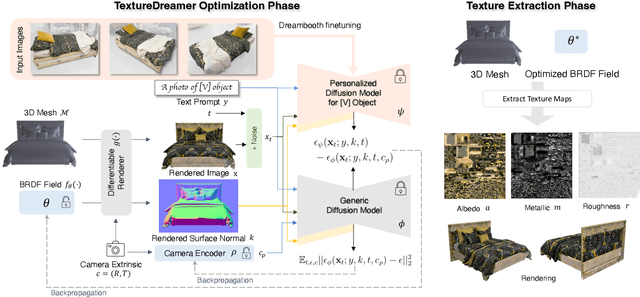
Abstract:We present TextureDreamer, a novel image-guided texture synthesis method to transfer relightable textures from a small number of input images (3 to 5) to target 3D shapes across arbitrary categories. Texture creation is a pivotal challenge in vision and graphics. Industrial companies hire experienced artists to manually craft textures for 3D assets. Classical methods require densely sampled views and accurately aligned geometry, while learning-based methods are confined to category-specific shapes within the dataset. In contrast, TextureDreamer can transfer highly detailed, intricate textures from real-world environments to arbitrary objects with only a few casually captured images, potentially significantly democratizing texture creation. Our core idea, personalized geometry-aware score distillation (PGSD), draws inspiration from recent advancements in diffuse models, including personalized modeling for texture information extraction, variational score distillation for detailed appearance synthesis, and explicit geometry guidance with ControlNet. Our integration and several essential modifications substantially improve the texture quality. Experiments on real images spanning different categories show that TextureDreamer can successfully transfer highly realistic, semantic meaningful texture to arbitrary objects, surpassing the visual quality of previous state-of-the-art.
 Add to Chrome
Add to Chrome Add to Firefox
Add to Firefox Add to Edge
Add to Edge